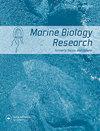韩国沿海地区分离的三种异养纳米鞭毛虫的形态、系统发育和生物地理特征
IF 1.2
4区 生物学
Q4 ECOLOGY
引用次数: 0
摘要
异养型纳米鞭毛虫(HNFs,大小2 ~ 20 μm)是水生环境中重要的细菌捕食者。我们从韩国沿海地区的样品中分离并鉴定了3株HNF菌株:肯氏弓形单胞菌KM086、mylnikovii自助餐菌株JS001和培养基多单胞菌JS004。他们的18S rDNA序列与之前已知的对应序列一致。在光镜下,所有菌株都符合之前各自的物种描述。然而,在扫描电子显微镜下,菌株JS004显示出一些与先前观察到的M. media不一致的特征,包括不同的推定外突体、“无褶边”的裙边和推定的“长牙”。利用122个地面站和13个不同深度站的Malaspina-2010数据,利用18S rDNA的V4区研究了全球物种分布。有趣的是,我们发现a . kenti在太平洋深海带(1000-4000米深)的低氧条件下最丰富,这表明在低氧栖息地中繁殖的专业化。相比之下,我们只在一个表面位点发现了M. media,而C. mylnikovii则完全没有发现。因此,肯塔基芽胞杆菌可能是低氧深海区最重要的细菌捕食者之一,而其他两种分离菌株在海洋系统中似乎是罕见的物种。本文章由计算机程序翻译,如有差异,请以英文原文为准。
Morphological, phylogenetic and biogeographic characterizations of three heterotrophic nanoflagellates isolated from coastal areas of Korea
Heterotrophic nanoflagellates (HNFs, 2–20 μm in size) are important bacterivores in aquatic environments. We isolated and distinguished three HNF strains from Korean coastal samples: Ancyromonas kenti strain KM086, Cafeteria mylnikovii strain JS001 and Multimonas media strain JS004. Their 18S rDNA sequences aligned with previously known counterparts. Under light microscopy, all strains match their previous respective species descriptions. However, under scanning electron microscopy, strain JS004 shows some features at odds with prior observations of M. media, including different putative extrusomes, an ‘unfrilled’ skirt margin, and a putative ‘tusk’. We also used the V4 region of 18S rDNA to study species distribution globally using Malaspina-2010 data from 122 surface stations and 13 various depth stations. Intriguingly, we found that A. kenti was most abundant in low-oxygen conditions of the bathypelagic zones (1000–4000 m deep) in the Pacific Ocean, suggesting a specialization for thriving in low-oxygen habitats. In contrast, we only found M. media represented at one surface site, and C. mylnikovii was not found at all. Thus, A. kenti may be one of the most important feeders on bacteria in the bathypelagic zones with low-oxygen concentrations, while the other two isolates appear to be rare species in marine systems.
求助全文
通过发布文献求助,成功后即可免费获取论文全文。
去求助
来源期刊

Marine Biology Research
生物-海洋与淡水生物学
CiteScore
2.10
自引率
0.00%
发文量
55
审稿时长
6-12 weeks
期刊介绍:
Marine Biology Research (MBRJ) provides a worldwide forum for key information, ideas and discussion on all areas of marine biology and biological oceanography. Founded in 2005 as a merger of two Scandinavian journals, Sarsia and Ophelia, MBRJ is based today at the Institute of Marine Research, Bergen, Norway. The Journal’s scope encompasses basic and applied research from all oceans and marine habitats and on all marine organisms, the main criterium for acceptance being quality.
 求助内容:
求助内容: 应助结果提醒方式:
应助结果提醒方式:


